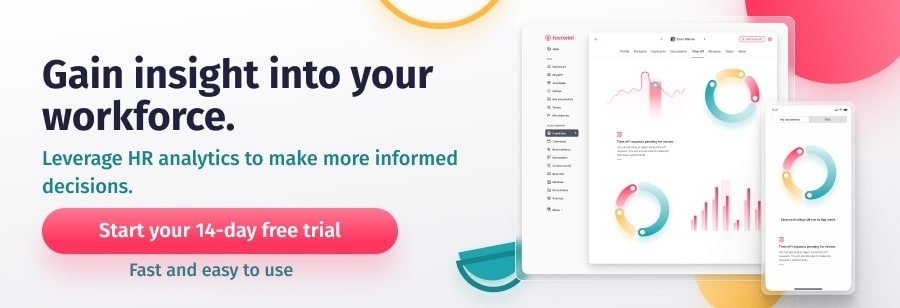Whether you’re overhauling your business plan or simply looking to optimize the day-to-day, gaining insight into your organization’s operations can make a world of difference. Workforce analytics provides the data necessary for efficient workforce strategizing and planning.
What, exactly, is workforce analytics? Some organizations may believe that it is simply measuring (headcounts, labor costs, turnover). However, this is not the case! Instead, this powerful tool is a systematic approach to defining workplace problems and finding sustainable solutions.
Here, we’ll cover everything you need to know starting with the workforce analytics definition and implementation, all the way through to current and future trends.
Workforce Analytics: The Basics
- What is Workforce Analytics?
- Workforce vs. People Analytics
- Benefits of Workforce Analytics
- Long term Effects for the Workforce
Implementing Workforce Analysis
- Facing Workforce Challenges
- Applying Predictive Analytics
- Planning with Workforce Analytics
- Tools for Workforce Analytics
The Future of Workforce Analytics
- Trends in Workforce Analytics
- COVID-19 and Workforce Management
- Are You Ready for Workforce Analytics?
✅ Collect the workplace data that’ll help you make better business decisions
What is Workforce Analytics?
Workforce analytics is the modeling of data (both qualitative and quantitative) in order to understand the past, present, and future drivers of organizational performance.
Analytics can be applied to recruitment, staffing, training and development, personnel, and compensation and benefits. It should be used to determine standard ratios such as time-to-fill, cost-per-hire, accession rate, retention rate, add rate, replacement rate, time-to-start, and offer acceptance rate.
Successful analysis will also unite data from across the business: financial, operational, sales, and people management software. Many organizations apply analytics to solve specific business problems. Meanwhile, others may benefit by using analytics to arrive at a better understanding of the needs of their workforce.
The Difference Between Workforce Analytics and People Analytics
In addition to “workforce analytics,” you may have heard terms such as “people analytics,” “talent analytics” or “HR analytics.” Although these phrases are sometimes used interchangeably, there are also important differences between them.
While “people analytics” focuses more on information around personnel and collecting employee data, “workforce analytics” functions on a larger scale. It is a more technology-driven approach to the workforce and talent management. Workforce analytics software is key for reporting, managing, and evaluating employee data. In short, its goal is to recognize, quantify, and improve the role of employees in the organization.
For example, when your organization searches for and employees a new employee, the goals guiding the business’s search will both be informed by workforce analytics. Employers use analytics on the current successes of employees to determine the most valued characteristics in new hires. They also may use analytics to determine where to list new job openings or how to best structure interview questions.
Gain valuable insights to add to your people analytics report 👇
Download your Employee Satisfaction Survey
Benefits of Workforce Analysis
Workforce analytics can help organizations streamline everything from recruiting methods to retention. Here’s our run-down of how analytics can beef up your business:
- Help managers make informed hiring decisions by predicting the probability of an individual employee’s success.
- Identify gaps in the current workforce and reveal the need for new positions and departments.
- Find instances of redundancy where departments or positions can be reassigned or eliminated.
- Determine and quantify risks to employees in specific positions.
- Pinpoint and quantify factors that impact employee engagement and job satisfaction.
- Analyze and predict current and also future technological needs.
- Optimize the enterprise’s organizational structure.
- Create clear pathways for achieving goals and delegating tasks and responsibilities.
- Increase transparency and boost employee satisfaction and engagement.
Above all, these tools can help improve efficiency across the workforce and equip leaders with data to make informed decisions about their organization’s future.

Longterm Effects of Workforce Analytics
A business that regularly deploys employee workforce analytics will be in a more powerful position. Responding to employee data more regularly, rather than in a once-a-year performance review, can lead to large systemic changes. Here are the positive shifts an organization may see with workforce analytics.
-
Improved Employee Engagement
Studies have shown that employee engagement is key to a business’s success; engaged employees are happier, more committed, and more productive. Workforce analytics can point out a road to nurturing the employee experience. Organizations use analytics to find what influences employee satisfaction, and what factors impact employee engagement. With this data under their belt, they can optimize the employee environment and support network.
-
Increased Training Efficiency
With workplace analytics, management can run reports to determine the efficacy of training programs. This will help them to modify training for future use and also provide insight into employee improvement opportunities. If an organization hopes to prioritize employee effectiveness (and employee well-being), there need to be adequate opportunities for employees to up- and re-skill. Analytics provides data to get these programs in place.
-
Strategic Planning
Make use of your business’s data! Analytics will help you to ask the right questions— and find solutions with real impact. Workforce analytics uses statistical tools and methodologies to get a real-time sense of how things are currently structured. This will help your business look forward to how things could be structured. Time to optimize employee performance and human resource management.
Implementing Workforce Analytics Strategies
Workforce Challenges
Workforce analytics is most efficient when applied to address specific problems. Here are some examples of workplace challenges your organization may be facing. Are you equipped to deal with them?
- Workforce planning: First of all, is your organization able to account for current and forecasted business needs?
- Talent acquisition and movement: Are you able to recruit according to your organization’s goals and values? Moreover, are you able to measure the effectiveness of recruiting efforts? Are you able to tap the right talent pools? It is critical to assess the future demand for skills— and the future supply.
- Workforce performance: Is your business able to use data to track top performers? Gauging and managing performance is key to creating an effective management structure that supports employee success.
- Training and development: Is your business able to create and evaluate effective training and learning programs? Can these programs be modified according to feedback and in alignment with company goals?
- Attrition: An organization can measure turnover among key workers in order to mitigate potential losses. Is your business equipped to understand why employees leave? Are you prepared to forecast who may intend to leave in the future?
Applying Workforce Predictive Analytics
Workforce analytics software can help you address the above issues. There are four kinds of analytics that will help provide insights into your company’s workforce. These are as follows:
- Descriptive Analytics: Gathers and analyzes data about the current state of affairs or past events.
- Predictive Analytics: Analyzes historical data to anticipate future outcomes and values. Uses information to optimize operations, improve employee experience, and implement corrective policies.
- Prescriptive Analytics: Suggests a course of action based on what has happened in the past. This tool is useful for industries with busy seasons, such as retail, tourism, and hospitality.
- Diagnostic Analytics: Determines the causes of problems discovered through descriptive analytics. Helps to identify the underlying cause and focus efforts toward eliminating the issue.
A good workforce analytics software will integrate all four of these approaches to provide you with a 360-degree view of where your business is and where you want to go.

Workforce Analytics and Planning
If your management team wants to use workforce analytics to answer a specific problem, there are some clear steps to follow in order to get the information you need.
-
Identify a workforce problem or question that needs to be solved.
With their values and objective in mind, organizations should ask themselves where they are falling short or how they can improve. Consider, for example, that employee engagement is down. An organization may question if they can best improve engagement through training programs, through more active performance management, or through other methods. Once you have identified the problem, the data will guide you toward a solution.
-
Determine what information is needed to interrogate the problem or question.
Once you have identified the problem, consider what evidence you need to come to a final answer. For example, if a business is hoping to improve employee engagement through training programs, they need to compare engagement stats (from surveys) to training program completion rates. Do employees who completed programs report being more satisfied in their positions?
-
Decide how to analyze and report the metrics.
Finally, it’s time to determine the relationships you must measure and analyze. To determine if employees who complete training programs are more engaged, you’ll need to compare the reported satisfaction of employees who have completed a training program and those who haven’t. Answers may of course lead to further questions. If you find the employee engagement is improved through training programs, you may wonder if some training programs are more successful than others. If employees are unhappy with training programs, you can investigate how they can be improved. Embrace the rabbit hole! This is the way you can get to the bottom of the problems.
Tools of Workforce Analytics: Workforce Analytics Software
When it comes to analytics, nothing is more important than choosing the right workforce analytics software. You need a platform that can help you track, interpret, and understand data. That means something with a clean interface, powerful capabilities, and easy-to-use tools. Good software will help you with every facet of your business planning and strategizing, such as:
-
Defining Your Business Objectives
Firstly, effective workforce analytics software will help you to think through your business objectives. Through custom HR reports on payroll, attendance, performance, and productivity, workforce analytics software gives you insight into every nook and cranny of your business. Don’t like what you see? Use this information to reorient your business toward your goals.
-
Modeling Current Workforce
Use an organizational chart in order to get a clearer picture of your current workforce. With the click of a button, you’ll have a view of each employee, their supervisor, and their position in the business. Is one supervisor responsible for many employees while others are skating by? Then, update the chart as needed and think through optimal arrangements.
-
Establish Orientation for Future Workforce
In order to you want to direct your business’s future, you need to develop records of the past. Performance management tracking can collect and organize feedback from managers and self-reports from all employees. This data will not only be invaluable to employees hoping to up their game. It will also help management to find new and better ways to support employees on their journey.
-
Address Workforce Gaps
With an applicant tracking system and streamlined onboarding workflows, analytics software will show you where your hiring practices are succeeding. Moreover, it will reveal where they are falling short. For example, is your training up to snuff? Are your hiring practices inclusive? The data will tell it like it is.
Software is certainly the most powerful workforce analytics tool you can invest in. Make sure to offer workforce analytics training to HR staff and management employees so that they can make the most of the new tools.

The Future of Workplace Analytics
Emerging Trends in Workforce Analytics
Done well, strategic workforce planning will certainly lead to greater innovation, talent generation, and progress in an organization. As more businesses turn to workplace analytics, emerging trends are revolutionizing employee management.
-
Real-Time Analytics
Workforce analytics software makes it easier for businesses to stay on top of their data. Therefore, more and more businesses are changing their feedback practices from one-time to all-the-time. No more yearly performance reviews! Now employees can get real-time feedback and learning data for year-round improvement. Managers can use the same data in order to organize training programs or initiatives to encourage employee engagement. In conclusion, it’s a win-win!
-
Pan-Enterprise Cooperation
Strategic workforce planning may be driven by HR, but in order to be successful, it needs to involve the entire organization. Rather than work alone, HR’s role is actually to facilitate communication between different parts of the business. Leadership, accounting, finance: everyone has a role to play here. Proactive organizations use workforce analytics in order to unify data from different sectors of the business.
-
Understanding the Skills of the Workforce
In a time where flexibility is king and jobs change rapidly, more businesses are prioritizing internal mobility. That is to say that businesses need to equip employees with skills to take advantage of new technologies and take on new responsibilities. Nowadays, workforce analytics helps businesses identify gaps in the workforce, re-organize, and plot careers for employees.
-
Focus on Productivity
Use analytics to orient your business away from the idea of jobs as set-in-stone roles. Instead, break jobs down into their component tasks and responsibilities, and explore what makes employees productive. Workforce analytics is increasingly concerned with boosting productivity by upskilling and training rather than simply seeking new talent.
COVID-19 and Workforce Management
COVID-19 has changed how work, well, works. For example, new technologies mean changing roles, modifying skills, and seeking new talent. In short, organizations are at a crossroads. Those which adapt quickly may be able to position themselves to retain talent and attract new hires even in an uncertain situation. However, those which don’t update their practices may be left behind. How can workforce analytics streamline your talent management in these strange times?
-
Rapid Reskilling
Now that everything is changing at breakneck speed, employees and employers alike have had a steep learning curve. Workforce analytics can help identify where employees need support with new technologies and changing roles.
-
Emphasis on Employee Well-being
The pandemic and the lock-down have put severe pressure on employees. The World Health Organization has reported increases in anxiety and depression around the world. Therefore employers need more programs to support mental health and prioritize employee well-being. That includes more trust, transparency, and above all, open communication. Workforce analytics can help organizations to pay more attention where it is most needed.
-
Maximize Flexibility
These days, businesses need to be prepared for whatever curveball comes their way. That means adapting at the organizational, departmental, and personal level. Peoples’ roles are more fluid than ever before and innovation is on the up-and-up. Workplace Analytics can help guide your business’s growth. Moreover, it can reveal the courses that don’t make as much sense.
Are You Ready for Workforce Analytics?
Workforce analytics has become even more important in today’s changing work landscape. Organizations with strategic workforce planning have an average of 10% higher business outcomes. Through the application of workforce analytics software, businesses can gain unprecedented insight into daily goings-on.
In short: organizations that make the effort to adapt and evolve may find their efforts are doubly rewarded. Is your business in need of direction? Are there places where improvement is necessary? Workforce analytics can guide your business’s growth and change.
Gain a better grasp on your Workforce Analytics with the help of real-time HR reports and employee data.
Written by: Valerie Slaughter


Very informative.